
The Santa Justa Lift, also called Carmo Lift, is an elevator, or lift, in the civil parish of Santa Justa, in the historic center of Lisbon, Portugal. Situated at the end of Rua de Santa Justa, it connects the lower streets of the Baixa with the higher Largo do Carmo.

The Monument of the Discoveries is a monument on the northern bank of the Tagus river estuary, in the civil parish of Santa Maria de Belém, Lisbon. Located along the river where ships departed to explore and trade with India and the Orient, the monument celebrates the Portuguese Age of Discovery during the 15th and 16th centuries.

The Teatro Real is an opera house in Madrid, Spain. Located at the Plaza de Oriente, opposite the Royal Palace, and known colloquially as El Real, it is considered the top institution of the performing and musical arts in the country and one of the most prestigious opera houses in Europe.
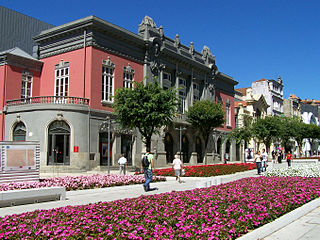
The Theatre Circo is a 20th-century, Portuguese revivalist theatre, in the civil parish of São João do Souto, municipality of Braga. Designed by the architect João de Moura Coutinho, it was first inaugurated on 21 April 1915 with a performance of Ruggero Leoncavallo's operetta La reginetta delle rose.

Theatre Camões is a concert hall situated in the civil parish of Parque das Nações, municipality of Lisbon.
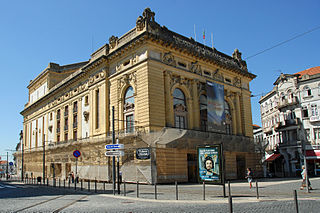
The São João Theatre, commonly referred to as the São João National Theatre is a Portuguese theatre and concert venue in civil parish of Cedofeita, Santo Ildefonso, Sé, Miragaia, São Nicolau e Vitória, in the municipality of Porto, in northern Portugal.

The Diogo Bernardes Theatre is a theatre in the civil parish of Arca e Ponte de Lima, in the municipality of Ponte de Lima, in the Portuguese district of Viana do Castelo.

Maria de Conceição de Matos Ferreira da Silva was a Portuguese actress and theatre personality.

João Garcia Miguel is a Portuguese theater director, playwright, visual artist and performer. He began his career in the 1990s and is generally characterized as a postdramatic theatre artist. His artistic performances have been described as "hybrid theater asserting an alternative concept of globalization, establishing an invigorating line of work, between the spectacle of society and the society of spectacle". One of the most visible and relevant aspects of Garcia Miguel's theatrical work is the way he reworks classic texts of European theater through disruption and innovation, using interactive technologies. Special Nothing/Especial Nada presented at the Edinburgh Fringe Festival was considered by The Herald as "a fabulous blast" and "the inspired springboard for a fascinating window into creative processes and what constitutes 'art'". Burgher King Lear was selected as one of the best 2006 Portuguese performances and described as one of the most accomplished and intelligent deconstructions of a classical theater text recently staged, achieving success in Spain, where it was awarded the FAD Sebastià Gash 2008 Prize (Barcelona).

The Roman Thermae of Maximinus, are the archaeological ruins of a monumental building and public baths, whose construction was integrated into the urban renewal of the civitas of Bracara Augusta, the Roman provincial capital of Gallaecia. The large public/civic construction consisted of a building, housing the baths and a theatre, although the archaeological excavations continue.
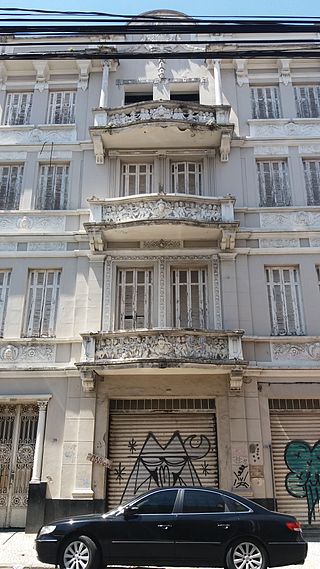
The Teatro Brasileiro de Comédia is located in the Bela Vista neighborhood, in the central zone of the Brazilian city of São Paulo. It was founded in 1948 by businessman Franco Zampari, with the financial support of part of São Paulo's elite.

Teatro O Bando is a Portuguese professional traveling theatre company active since 1974. According to its official website, it is "[a] collective that elects aesthetic transfiguration has a civic and community participation".

João Guedes Branco is a French-born Portuguese theatrical actor and reviewer, professor, and programmer. He had a theatrical career for over 30 years and appeared in more than 50 plays, most of them in Mindelo, Cape Verde.
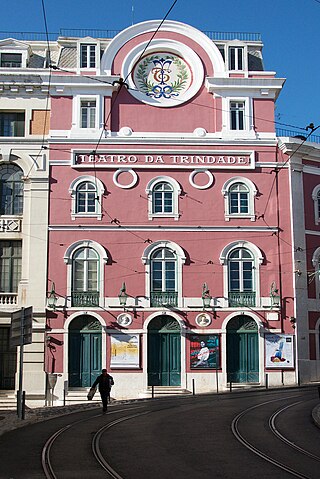
The Teatro da Trindade is a theatre in the Chiado neighbourhood of Lisbon, Portugal, built in the 19th century. It is one of the oldest theatres in Lisbon still in operation.

The Teatro Politeama is a theatre in Lisbon, Portugal that opened in 1913.

The Teatro São Luiz is a theatre located in the Chiado district of the Portuguese capital of Lisbon. It opened on 22 May 1894.
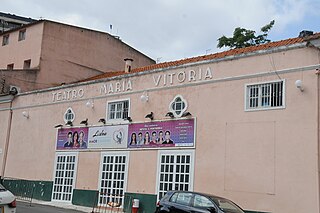
The Teatro Maria Vitória is a theatre in Lisbon, capital of Portugal. It is located in the theatre district of Parque Mayer.

The Teatro do Ginásio was a theatre in Lisbon, Portugal that mainly concentrated on performances of comedy shows.

The European Theatre Convention (ETC) is a European theatre association founded in 1988.





















